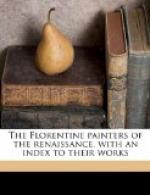Masaccio, then, like Giotto a century earlier,—himself the Giotto of an artistically more propitious world—was, as an artist, a great master of the significant, and, as a painter, endowed to the highest degree with a sense of tactile values, and with a skill in rendering them. In a career of but few years he gave to Florentine painting the direction it pursued to the end. In many ways he reminds us of the young Bellini. Who knows? Had he but lived as long, he might have laid the foundation for a painting not less delightful and far more profound than that of Venice. As it was, his frescoes at once became, and for as long as there were real artists among them remained, the training-school of Florentine painters.
V.
Masaccio’s death left Florentine painting in the hands of three men older, and two somewhat younger than himself, all men of great talent, if not of genius, each of whom—the former to the extent habits already formed would permit, the latter overwhelmingly, felt his influence. The older, who, but for Masaccio, would themselves have been the sole determining personalities in their art, were Fra Angelico, Paolo Uccello, and Andrea del Castagno; the younger, Domenico Veneziano and Fra Filippo. As these were the men who for a whole generation after Masaccio’s death remained at the head of their craft, forming the taste of the public, and communicating their habits and aspirations to their pupils, we at this point can scarcely do better than try to get some notion of each of them and of the general art tendencies they represented.
[Page heading: PAOLO UCCELLO]
Fra Angelico we know already as the painter who devoted his life to picturing the departing mediaeval vision of a heaven upon earth. Nothing could have been farther from the purpose of Uccello and Castagno. Different as these two were from each other, they have this much in common, that in their works which remain to us, dating, it is true, from their years of maturity, there is no touch of mediaeval sentiment, no note of transition. As artists they belonged entirely to the new era, and they stand at the beginning of the Renaissance as types of two tendencies which were to prevail in Florence throughout the whole of the fifteenth century, partly supplementing and partly undoing the teaching of Masaccio.
Uccello had a sense of tactile values and a feeling for colour, but in so far as he used these gifts at all, it was to illustrate scientific problems. His real passion was perspective, and painting was to him a mere occasion for solving some problem in this science, and displaying his mastery over its difficulties. Accordingly he composed pictures in which he contrived to get as many lines as possible leading the eye inward. Prostrate horses, dead or dying cavaliers, broken lances, ploughed fields, Noah’s arks, are used by him with scarcely an attempt at disguise, to serve his scheme of mathematically




